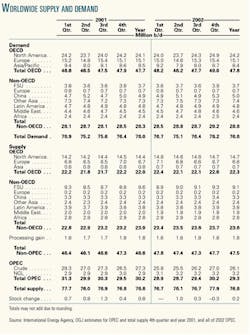Production restraint will be the key to the international oil market this year. Until economies of major oil-consuming countries rebound, crude oil prices will be unusually sensitive to quota compliance by members of the Organization of Petroleum Exporting Countries and to amounts by which nonmembers reduce output.
OPEC lost market share last year as large producers outside the organization - Russia, Norway, and Mexico - kept output high as the exporters' group lowered quotas in an effort to stabilize prices while demand was falling.
OPEC implemented three quota reductions in 2001, totaling 3.5 million b/d. On Dec. 28, the organization agreed on a further 1.5 million b/d cut effective Jan. 1.
But it made the agreement contingent on the participation of Russia, Norway, Angola, Mexico, and Oman, which agreed to reduce exports by nearly 500,000 b/d. Alone, Russia increased output by that amount during 2001.
This latest agreement, which puts OPEC production at 21.7 million b/d, is set to last for at least 6 months but will be evaluated at a March meet ing.
Demand
Throughout the year, the International Energy Agency ratcheted down its estimate of global oil demand growth for 2001, finally settling on a gain of 140,000 b/d.
Economic conditions in Japan, Germany, and the US worsened as the year progressed.
Japan's economy fell into recession after gross domestic product (GDP) declined in the second and third quarters. Germany's economy contracted during the third quarter.
In the US, the worsening of economic conditions after the Sept. 11 terrorist attacks in New York and Washington, DC, joined warmer-than-normal weather to suppress demand for oil.
IEA forecasts that demand for petroleum in Organization for Economic Cooperation and Development countries will increase 100,000 b/d this year (see table).
Among these countries, IEA expects demand in the US to increase 140,000 b/d and in Japan to decline 70,000 b/d.
Non-OECD demand will move up 500,000 b/d, according to the Paris-based agency. Petroleum demand in the former Soviet Union is estimated to increase 60,000 b/d, while demand growth in China is forecast at 160,000 b/d.
Outlook
Falling demand resulted in plentiful stocks and lower prices last year. If these variables are to return to more comfortable levels for suppliers, output must be carefully managed this year.
IEA estimates that in 2002, global oil demand will increase 600,000 b/d, while total non-OPEC supply grows 900,000 b/d.
OGJ estimates that in the first quarter of this year, OPEC will lower output of crude to 25.8 million b/d from an average 26.5 million b/d in the fourth quarter of last year.
This would leave stocks unchanged for the quarter, as supply equals demand.
During the second quarter, when demand is typically low, OPEC production is forecast to dip, and non-OPEC output is expected to decline by 400,000 b/d, resulting in a 1 million b/d increase in stocks.
OGJ expects many of the larger economies to recover near the middle of this year, and demand and production are projected to pick up momentum in the second half of the year.
IEA estimates total demand at 76.4 million b/d during the third quarter. If non-OPEC production averages 47.3 million b/d for the period, OPEC crude output can increase to average 26.2 million b/d and still allow for a 300,000 b/d stockbuild.
If total demand rebounds in the fourth quarter to average 78.2 million b/d, as IEA forecasts, then an increase in OPEC output to 27 million b/d and another small increase in non-OPEC production will result in a draw of stocks equal to the build in the previous quarter.



